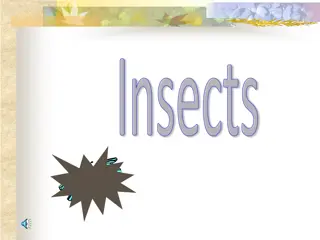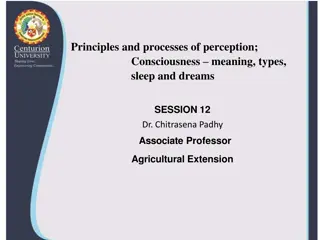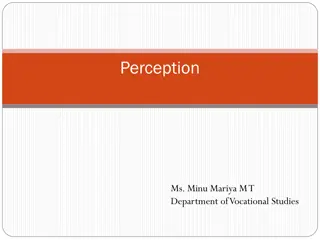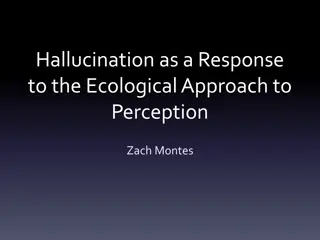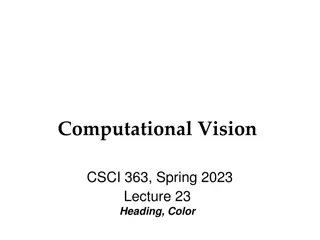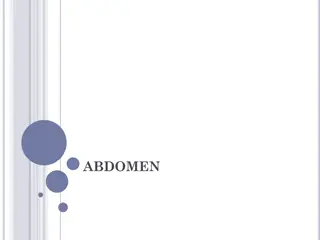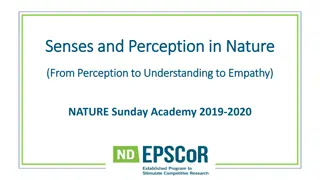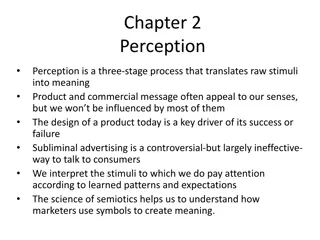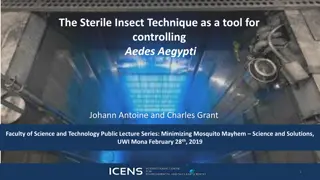Understanding Light Perception in Insects
Insects perceive light through various receptors such as compound eyes, ocelli, and stemmata. Compound eyes, made up of ommatidia, play a key role in capturing light stimuli ranging from UV to red wavelengths. Different types of compound eyes, like dioptric and holoptic, form images differently for diurnal and nocturnal insects. This comprehensive overview delves into the intricate mechanisms of how insects sense and process light information.
Download Presentation

Please find below an Image/Link to download the presentation.
The content on the website is provided AS IS for your information and personal use only. It may not be sold, licensed, or shared on other websites without obtaining consent from the author. Download presentation by click this link. If you encounter any issues during the download, it is possible that the publisher has removed the file from their server.
E N D
Presentation Transcript
INTRODUCTION Light is perceived by insects through a number of different receptors. Most adult insects and larval hemimetabolous insects have a pair of compound eyes and often three single- lens eyes, called Ocelli on the dorsal side of the head. Larval holometabolus insects have one or more single-lens eyes, known as Stemmata, on lateral sides of the head. Some insects are also known to possess Epidermal Light Receptors, and, in some cases, light is known to have Direct Effect On Cells In The Brain. The light-sensitive receptors of insects, the compound eyes, ocelli, and stemmata, responds to light from about 350nm(UV)- 700nm(RED)
Compound eyes Compound eyes are so called because they are constructed of several thousands of similar units called ommatidia. Most adult insects have a pair of compound eyes. Presents in most adults Pterygote Insects And The Larvae of Hemimetabolus Insects. Absents or Reduced in wingless parasitic groups like fleas, female mealy bugs,etc nd in some species that live in very dark places. Compound eyes may be: a) Dicoptic: viewing a separate and independent field by each eye. In dichoptic presentation, stimulus A is presented to the left eye and a different stimulus B is presented to the right eye. b) Holoptic: : holoptic eyes meet along the median dorsal line of the head, in many species nearly covering the exterior of the head. Each eye is made up of severalthousands of Ommatidia Or Facets. Ommitidia consists of : Optic Part , Sensory Part. Four types of Facets-a) Eucone, b)Acone, c ) Pseudocone, d) Exocone
Ommatidium .Ommatidia are basic unit of compound eyes. It contains a cluster of photoreceptor cells surrounded by support cells and pigment cells. The outer part of the ommatidium is overlaid with a transparent cornea. They vary in size and number The sizes of ommatidia vary from about 5 to 40 microns in diameter. Components: a) Optical part, optical eye consists of Corneal lens,crystalline cone. b) Sensory part consits ofRhabdome cell, Retinula cells. A nerve axon projects from each retinula cell.Each ommatidium has its own an optic nerve. Surface view of facets of a compound Ommatidium
Types of image Two types of images are formed: Diurnal insects forms the apposition image and they are active during the day. Nocturnal insects forms the superposition eye and they are mainly active in night. a) Apposition Eyes/ Photopic Eyes: Apposition eyes are the most common form of eyes and are presumably the ancestral form of compound eyes. Apposition eyes work by gathering a number of images, one from each ommatidium, and combining them in the brain, with each eye typically contributing a single point of information. The typical apposition eye has a lens focusing light from one direction on the rhabdom, while light from other directions is absorbed by the dark wall of the ommatidium. b) Superposition Eyes/ Scotopic Eyes: Superposition eye has a gap between the lens and the rhabdom, and no side wall. Each lens takes light at an angle to its axis and reflects it to the same angle on the other side. The result is an image at half the radius of the eye, which is where the tips of the rhabdoms are. This type of compound eye, for which a minimal size exists below which effective superposition cannot occur, is normally found in nocturnal insects, because it can create images up to 1000 times brighter than equivalent apposition eyes, though at the cost of reduced resolution.[
Resolution: The degree of fineness with whichan eye forms an image of the object. oPresence of the interommatidial angle. oIn appostion eyes, the fineness of image will be greater the smaller the ommatidial angle. oThe degree of resolution is decreased when the eye becomes dark adapted and light from a greater area is admitted to each unit. Fig: Day eyes and Night eyes. Transduction: The conversion of electrical energy involves the visual pigment. This is chromoprotein belonging to a group of chromoproteins known as Rhodopsins. Adaptation: The natural change from darkness to full light involves change in light intensity.it may be of two types in eyes: a) the amount of light reaching photoreceptors is regulated. Eg; in ant Camponotus shown infigure. b) The receptor sensitivity can be changed.
Significance of Compound Eyes Flicker effect The compound eye is excellent at detecting motion.As an object moves ommatidia are turned on and off. Distance Perception Most insects must be able to judge distance.As in prey catching insects, in grasshopper s jumping, and when they are landing.Simultaneous stimulation of ommatidia. Visual tracking An animal s ability to keep a moving target within specific area of the retina, often when the animal itself is moving. For examples, when a predator such as a mantisor dragonfly catches its prey, or when a male fly pursues a female.
Color vision Not all insects see colors. But maximum adsorption is in the green range of spectrum(490-540nm). Most insects shows maximum sensitivity to wavelength in ultraviolet and another with maximum absorption in the blue range. But for majority insects, red color does not stimulates the eye. Honey bees can differentiate yellow, blue-green, violet, ultraviolet, purple but not red. Figure showing Rove Bettle.
Dorsal ocelli: Found in adult insects and the larvae of hemimetabolous insects. Three ocelli forming are inverted triangle antero-dorsally on the head. The ocelli are lost or absent in wingless form. Ocelli are adapted for the concentration of light and perception of changes inintensity, a pathway for rapid conduction. Stemmata( lateral ocelli): Visual organs of larval holometabolous insects. It is laterally on the head and vary in number from one in sawfly larvae to six on each side in lepidopteran larva. Stemmata are of two types: a. Those with single rhabdom: eg: mecoptera, neuroptera, etc. b. Those with multiple rhabdom: eg:grubs of adephaga, sawfly larva,etc.
Other Visual Receptors Dermal Light Sense: A number of insects, such as tenebrio larvae, still respond to light when all the known visual receptors are occluded. The epidermal cells are apparently sensitive to light. Sensitivity Of The Brain: In several insects species, light affects neural activity directly by acting on the brain, not via the compound eyes orocelli. In some species, daylength, regulating diapause, is registered directly by the brain



